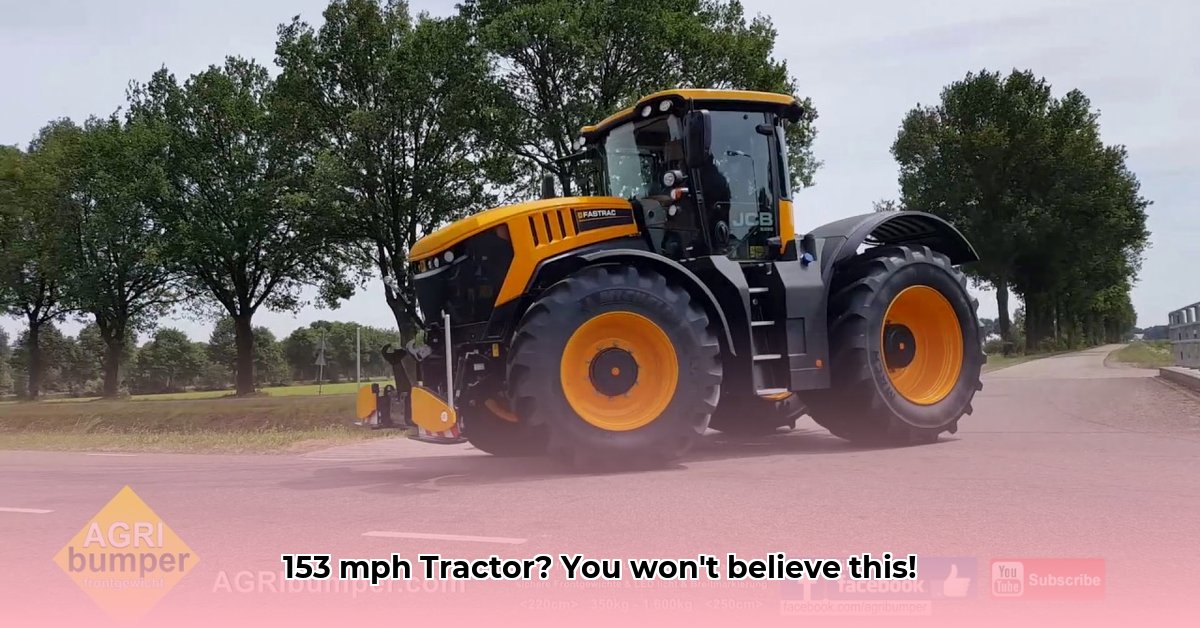
JCB Fastrac's 153 mph Achievement: A Deep Dive into Engineering and Agricultural Innovation
The JCB Fastrac's recent record-breaking speed of 153.771 mph (247.5 km/h) isn't merely a headline-grabbing stunt; it represents a significant leap forward in agricultural engineering and the potential for transformative change in farming practices. This achievement showcases the remarkable synergy between cutting-edge technology and the persistent pursuit of higher efficiency within the agricultural sector. But what does this mean for the future of farming? For more details on this record, see the JCB Fastrac Top Speed page.
Building a Tractor for Breakneck Speeds: A Technological Masterpiece
Achieving a speed previously unheard of for agricultural machinery demanded a radical redesign of the Fastrac. The transformation wasn't just about adding horsepower; it involved a holistic engineering approach, drawing parallels to advancements in high-performance automotive engineering.
At the heart of this feat lies a powerful, over-1000 horsepower diesel engine—a significant jump from standard agricultural tractors. This raw power, however, needed to be channeled effectively, necessitating equally impressive advancements in other areas. How did they manage such incredible speeds without compromising the integrity of the machine? The answer lies in advanced aerodynamics.
JCB collaborated with Williams Advanced Engineering, renowned for their expertise in Formula One racing. This partnership resulted in significant aerodynamic improvements. Through rigorous computer modeling and wind tunnel testing, they managed a remarkable 10% reduction in drag compared to previous models. This reduction in wind resistance, coupled with the massive engine power, allowed them to attain the record-breaking speed.
But raw power and aerodynamics alone are insufficient for such speeds. Imagine trying to maneuver a vehicle at 150 mph without precise control—a recipe for disaster. To mitigate this, JCB implemented state-of-the-art handling and braking systems. This crucial aspect required significant modifications to the suspension, steering, and braking components, ensuring stability and safety even at extreme speeds. The resulting system offers precision control previously unattainable in agricultural machinery at these velocity levels.
Beyond the Numbers: A Milestone in Agricultural Technology
The 153 mph achievement isn't simply about surpassing a speed record; it underscores the potential of agricultural technology. The trial run, conducted at the aptly named Elvington Airfield, a site ideal for high-speed testing, served as a powerful demonstration of what's possible. But how will this translate into the everyday realities of farming?
While we won't see farmers routinely driving at 150 mph across their fields, the underlying technology holds immense promise. The advancements in engine efficiency, aerodynamics, and handling directly translate to tangible benefits for everyday agricultural tasks. Can we expect immediate changes to current farming practices? Probably not. However, the implications are wide-reaching and significant. Imagine the potential for increased fuel efficiency at normal operating speeds. Imagine tractors capable of covering vast distances rapidly, dramatically increasing operational efficiency, especially on large farms.
Practical Applications: Redefining Agricultural Efficiency
The practical applications of this technological leap extend beyond mere speed. The implications for everyday farming are profound. Consider the possibilities:
- Faster Crop Spraying: Covering larger areas in shorter timescales implies greater efficiency and reduced operational costs.
- Improved Transportation: Moving goods and materials between fields becomes significantly faster, leading to reduced labor and time requirements.
- Enhanced Fuel Efficiency: The aerodynamic improvements and engine optimizations lead to greater fuel efficiency, even at lower speeds, reducing operational costs and the environmental impact.
These advancements point towards a future where farming operations are faster, more efficient, and more sustainable.
Navigating the Future: Challenges and Uncertainties
Despite the excitement surrounding the record-breaking speed, significant challenges remain. The high cost of implementing these high-performance features in commercially available tractors is a major obstacle. Furthermore, the increased power and speed will likely demand enhanced maintenance and potentially reduce the overall lifespan of the equipment. These factors need careful consideration before widespread adoption.
Moreover, safety remains a paramount concern. The potential risks associated with operating high-speed machinery necessitate new safety regulations and extensive operator training programs. Thorough risk assessment and safety protocols need to be developed and implemented to reduce the likelihood of accidents and ensure operator safety. Investigating the liability implications associated with high-speed operation is critical.
Key Advancements and Their Impacts:
- Enhanced Engine Power (Over 1000 hp): Enables unprecedented speeds, but increases cost and maintenance requirements.
- Advanced Aerodynamics (10% drag reduction): Improves fuel efficiency and allows for higher top speeds.
- State-of-the-Art Handling and Braking Systems: Crucial for safety and control at high speeds, demanding advanced technology and precise calibration.
The JCB Fastrac's record-breaking speed marks a significant milestone, but it also highlights the numerous challenges ahead. Further research and development are crucial to ensure the safe, cost-effective, and sustainable integration of these advancements into mainstream agricultural practices. The future of farming may very well be faster than we ever imagined. However, a careful, measured approach is necessary to realize this potential fully.